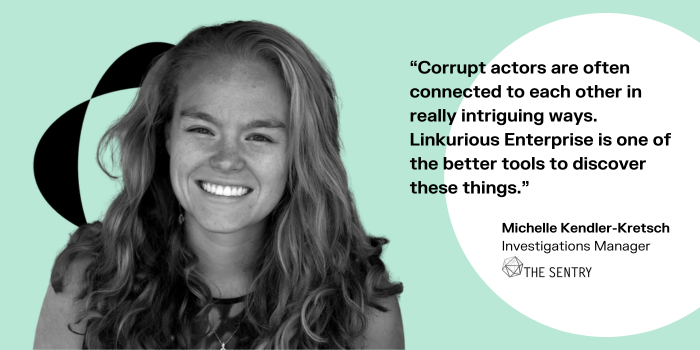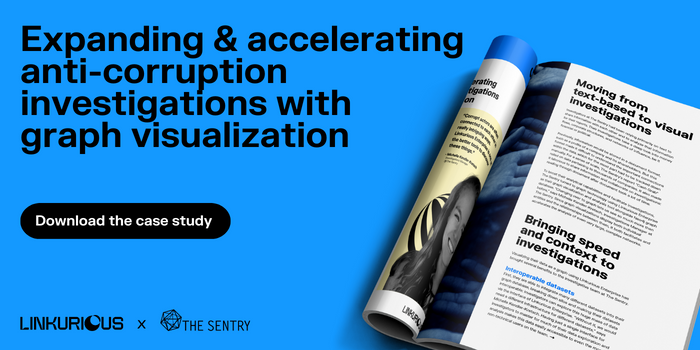The Sentry: Expanding and accelerating anti-corruption investigations with graph visualization
The Sentry is an investigative and policy organization that seeks to disable multinational predatory networks that benefit from violent conflict, repression, and kleptocracy. Their investigative teams dig into the networks of grand corruption that fuel wars, mass atrocities, and other human rights abuses.
To produce their reports, investigators at The Sentry comb through huge amounts of data related to ownership structures, family connections, money flows, and more. And they need to understand the complex connections within that data. To facilitate the data-based portions of their investigations, The Sentry turned to graph visualization.
Since the organization’s foundation in 2016, it has produced a series of hard-hitting and meticulously researched reports on individuals and entities connected to grand corruption and violence. Many of their investigations are focused on central Africa.
Recent reports have included: detailed information on a national security service responsible for grave human rights abuses securing power through shareholder positions in a vast network of companies; misappropriation of public funds by government-linked figures to buy luxury real estate; and a central African kleptocracy providing safe haven for a fugitive criminal suspected of terrorist financing. Through strategic partnerships with governments, global banks, and other private and public organizations, The Sentry has succeeded in creating real consequences for many of the officials and commercial actors perpetuating and profiting from war, mass atrocities, and other human rights abuses.
Investigators at The Sentry had been relying primarily on text to share information with each other and to analyze that information for their reports. Their investigations take a deep look into money flows, corporate structures, and networks of influence, be it financial or political.
Previously, information would be stored in a document format, such as a profile of a company and its shareholders. But this format made it difficult to understand the important connections within the data, which for the most part had to be tracked down manually. For a sense of scale, The Sentry’s report “Cash Grab” relied on data pertaining to thousands of companies. It also made it laborious to share information and collaborate on investigations: reading through document after document took a lot of time.
To boost their analytical capabilities and facilitate investigations, The Sentry turned to graph technology using Linkurious Enterprise as their graph visualization and analysis tool alongside Neo4j graph database. “Changing over to graph lets us see so much more than before,” says Michelle Kendler-Kretsch, Investigations Manager at The Sentry. Since graph visualizations display both individual entities and the relationships between them, it both facilitates and accelerates the analysis of even very large, complex networks.
Visualizing their data as a graph using Linkurious Enterprise has brought several benefits to the investigative team at The Sentry.
First, they are able to integrate many different datasets into their graph database, breaking down silos and making their datasets interoperable: investigators can explore this huge mass of data via the interface of Linkurious Enterprise. “Without it, we would need a different infrastructure for different datasets,” says Michelle Kendler-Kretsch. Having just a single interface for investigators to master for much of their data exploration and analysis makes this data easily accessible to even the more non-technical users on the team.
Having all their data centrally available to visualize and explore ensures that the entire investigative team has easy access to the knowledge stored within. Linkurious Enterprise’s user-friendly interface makes it easy for anyone to get started. “For our interns, for example, it speeds up their ability to start working with the team. It would take them much longer to start being productive otherwise,” says Michelle Kendler-Kretsch. It also makes it easier to conduct investigations overall. “It’s very user-friendly, which makes me feel like I’m in control and can focus on my investigations,” adds Michelle Kendler-Kretsch.
Graph allows for intuitive exploration of data. Investigators at The Sentry find they are able to discover connections and information they weren’t necessarily looking for. They can query their data with specific questions - like what entities are connected to companies evading sanctions, or what businesses are linked to one known to support terrorism - which turns up answers quickly. But investigators can also start exploring their graph visualizations to make chance discoveries that add context and information to their open investigations. “It’s like going into a store and asking for what you want versus browsing the store. Graph allows for serendipitous discoveries,” says Adi Eyal, Data Investigations Lead at The Sentry.
Certain features within the software have proven particularly helpful. Custom Actions, which enable users to integrate external sources or applications into their investigation workflows, have been an asset. “These workflows let us know everything we ever wanted to know, and beyond what we thought we wanted to know about a person in the context of an investigation,” says Michelle Kendler-Kretsch. Investigative teams can set up workflows to suit their needs and search through other resources, such as PEP data, all within Linkurious Enterprise.
Query templates help them simplify and accelerate their investigations. Because they work with so many datasets, the team frequently uses query templates to merge data. It also lets them find relevant information faster. “Sometimes our policy team is looking for specific case studies and we will use queries to find good examples for them to build their analysis around,” says Michelle Kendler-Kretsch.
Finally, The Sentry’s graph tools facilitate collaboration and discovery: within Linkurious Enterprise, investigators can use shared spaces to see what their teammates are working on, opening the possibility of linking related cases. Considering The Sentry’s area of focus, this is an asset. “Corrupt actors are often connected to each other in really intriguing ways,” says Michelle Kendler-Kretsch. “Linkurious Enterprise is one of the better tools to discover these things.” Take the example of family connections: these can be very complex structures, but once they are imported into the graph, it’s easy to map and understand these networks, which can be important sources of information on influence and corruption.

The Sentry has now imported vast amounts of data into their graph database, which they can visualize and analyze via Linkurious Enterprise. Currently their database stores around 200 million nodes and 150 million edges, and the number of nodes is roughly doubling every six months. The data team frequently adds new data sources to build on the resources available to the investigation teams, allowing them to dig deeper into the stories that expose corruption and abuse. Recently they imported data from OpenSanctions, which brings together an international database of sanctions lists and lists of politically exposed persons, all in a well-defined format for easy use and integration.
Looking towards the future, the team at The Sentry are hoping to extend the kind of storytelling they do with their data. With the right investigation, they imagine offering interactive exploration of networks of influence and corruption to the public, to enable readers to explore these networks themselves via publicly available graph visualization widgets.
A spotlight on graph technology directly in your inbox.
